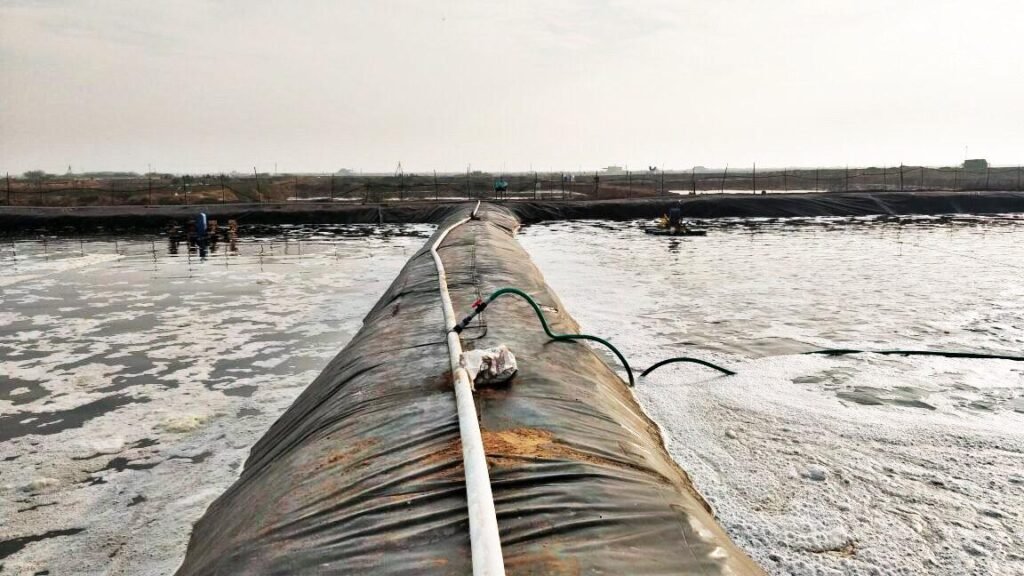Pond lining sheets have become an essential component in modern pond construction, offering durability, flexibility, and excellent water retention properties. Whether you’re creating an ornamental garden pond or a large agricultural reservoir, pond lining sheets play a critical role in ensuring the structural integrity and longevity of your water feature. In this article, we will dive into the various types of pond lining sheets, their benefits, installation techniques, and why they are the ideal solution for maintaining the health and sustainability of your pond.
What are Pond Lining Sheets?
Pond lining sheets are impermeable membranes that are used to retain water in artificial ponds or reservoirs. These sheets create a barrier between the water and the soil, preventing seepage and ensuring that the water stays within the pond. Available in various materials, including HDPE (High-Density Polyethylene), EPDM (Ethylene Propylene Diene Monomer), and PVC (Polyvinyl Chloride), pond lining sheets can be customized based on the type of pond, its size, and its specific requirements.
Types of Pond Lining Sheets
- HDPE Pond Lining Sheets
- HDPE sheets are among the most popular choices for pond liners due to their superior strength, puncture resistance, and UV stability. These liners are ideal for larger ponds, such as agricultural reservoirs, because of their ability to handle extreme weather conditions and withstand heavy loads.
- EPDM Pond Lining Sheets
- EPDM is a synthetic rubber sheet known for its flexibility and elasticity. It is an excellent option for ponds with irregular shapes, as it can easily conform to curves and slopes. EPDM sheets are also resistant to UV rays, ozone, and oxidation, making them durable and long-lasting.
- PVC Pond Lining Sheets
- PVC liners are an affordable alternative for smaller ponds or residential water features. While not as robust as HDPE or EPDM, PVC sheets are easy to install and can be welded together for custom shapes. They are suitable for ornamental ponds, fish ponds, and decorative fountains.
Key Benefits of Pond Lining Sheets
1. Prevent Water Seepage
One of the primary reasons for using pond lining sheets is to prevent water loss through seepage. Without an impermeable barrier, water can easily escape into the surrounding soil, leading to reduced water levels and higher maintenance costs. Pond liners act as a waterproof layer, retaining water within the pond and ensuring long-term sustainability.
2. Enhance Water Quality
Pond lining sheets contribute significantly to maintaining water quality. By preventing the soil and debris from entering the pond, liners reduce the risk of contamination, algae growth, and sediment buildup. This is especially important for fish ponds and aquaculture systems, where water quality directly impacts the health and well-being of aquatic life.
3. Durable and Long-lasting
Pond liners, especially those made from HDPE and EPDM, are highly durable and resistant to wear and tear. These materials can withstand harsh environmental conditions, such as extreme temperatures, UV radiation, and exposure to chemicals. A properly installed pond liner can last for decades, reducing the need for frequent repairs or replacements.
4. Easy Installation
Despite the advanced technology behind modern pond lining sheets, they are relatively easy to install. Most liners are available in large rolls that can be laid out in the pond and cut to size. Additionally, the flexibility of materials like EPDM makes it easy to adapt the liner to the contours of the pond, ensuring a snug fit without compromising on performance.
Choosing the Right Pond Lining Sheet
When selecting the ideal pond liner, several factors need to be considered:
- Pond Size and Shape: For large or irregularly shaped ponds, EPDM or HDPE liners are preferable due to their flexibility and strength. For small or decorative ponds, PVC liners may be more cost-effective.
- Water Retention Requirements: If you need a pond with a high degree of water retention (such as in agricultural or industrial applications), opt for a HDPE liner, as it offers superior impermeability.
- Environmental Conditions: Consider the environmental factors such as UV exposure, temperature extremes, and the presence of chemicals. HDPE and EPDM liners are more resistant to UV rays and chemicals, making them ideal for outdoor ponds that are exposed to the elements.
Installation Process for Pond Lining Sheets
1. Site Preparation
- Begin by excavating the pond area according to the desired dimensions and shape. Ensure that the bottom and sides of the pond are smooth and free of sharp objects like rocks and roots, which could puncture the liner. A layer of sand or geotextile fabric can be added for additional protection.
2. Measuring and Cutting the Liner
- Measure the pond’s length, width, and depth, and cut the pond liner accordingly. Always allow extra material to account for the pond’s depth and any curves or slopes.
3. Installing the Liner
- Once the liner is cut, carefully place it inside the pond. Start from the center and work your way towards the edges, ensuring that the liner conforms to the pond’s contours. Use rocks or sandbags to hold the liner in place temporarily as you adjust it.
4. Securing the Edges
- The edges of the liner should extend beyond the pond’s perimeter to prevent slippage. Secure the edges by placing heavy rocks, pavers, or soil on top of the liner to keep it in place. Trim any excess material for a clean, finished look.
5. Filling the Pond
- Once the liner is properly positioned and secured, begin filling the pond with water. As the pond fills, the liner will settle into place. Continuously adjust the liner during this process to eliminate wrinkles or folds.
Maintenance Tips for Pond Lining Sheets
To ensure the longevity of your pond liner, follow these maintenance tips:
- Regular Inspection: Periodically check the liner for any signs of damage, punctures, or leaks. Early detection of small issues can prevent larger problems down the road.
- Debris Removal: Keep the pond free of debris such as leaves, branches, and sharp objects that could damage the liner. Using a pond net or skimmer will help maintain a clean surface.
- Water Level Monitoring: Consistently monitor the pond’s water level. A sudden drop in water level could indicate a leak or puncture in the liner that needs immediate attention.
Why Pond Lining Sheets are Essential for Sustainable Water Management
In today’s world, where water conservation is a growing concern, pond lining sheets provide a sustainable solution for managing water resources efficiently. Whether for agricultural use, aquaculture, or aesthetic purposes, these liners ensure that water is retained where it is needed, reducing wastage and improving water quality. Furthermore, their durability and ease of installation make them a cost-effective investment for anyone looking to build or maintain a pond.
Pond lining sheets are undeniably a cornerstone of modern pond construction, but the benefits and potential go even deeper. Beyond the basic installation, proper selection, and care, there are advanced factors to consider to ensure that you extract the full potential of your pond lining system. These factors influence the longevity, environmental impact, and overall success of your water feature. In this section, we’ll cover advanced tips, environmental benefits, and frequently asked questions related to pond lining sheets.
Factors Influencing the Lifespan of Pond Lining Sheets
1. Thickness of the Liner
One of the key determinants of a pond liner’s durability is its thickness. Thicker liners provide better resistance to punctures, wear, and environmental elements. Typically, HDPE liners are available in a range of thicknesses, from 20 mil (0.5 mm) to 60 mil (1.5 mm), with the latter being ideal for larger, high-traffic ponds or areas prone to sharp objects.
2. UV Resistance
Exposure to sunlight and UV radiation is one of the leading causes of liner degradation, especially in outdoor ponds. UV-resistant liners, such as HDPE and EPDM, are specifically designed to withstand long-term exposure to the sun’s harmful rays, preventing cracking, brittleness, and breakdown over time. For optimal performance, consider installing a UV-stabilized pond liner, especially in regions with high sun exposure.
3. Chemical Resistance
Certain ponds, particularly those used in agricultural or industrial settings, may come into contact with chemicals or fertilizers that could degrade a standard pond liner. Both HDPE and EPDM liners offer high levels of resistance to chemicals, making them ideal choices for ponds where there’s a risk of chemical exposure. PVC liners, while cheaper, are more susceptible to degradation from certain chemicals and should be chosen carefully for such applications.
4. Temperature Fluctuations
Pond liners are often exposed to extreme temperature changes, especially in regions with hot summers and freezing winters. Liners such as EPDM offer excellent elasticity, allowing them to expand and contract without tearing, even in extreme conditions. HDPE, while incredibly durable, may become slightly rigid in cold weather, so ensuring the correct thickness and installation is crucial in colder climates.
Environmental Benefits of Using Pond Lining Sheets
In addition to their practical benefits, pond lining sheets are also an environmentally friendly choice for water management. Here’s how:
1. Water Conservation
By preventing water loss due to seepage, pond liners conserve water, reducing the need for frequent refilling. This is particularly important in areas prone to drought or where water resources are scarce. Efficient water management through the use of pond liners minimizes waste and helps maintain consistent water levels for irrigation, livestock, or wildlife use.
2. Reduced Chemical Leaching
Pond lining sheets create a barrier between the pond water and the underlying soil, preventing chemicals and pollutants in the soil from leaching into the water. This is crucial in areas where the soil may contain contaminants such as pesticides, heavy metals, or fertilizers. By keeping these harmful substances out of the pond, pond liners help maintain water purity and protect aquatic life.
3. Aquatic Life Protection
For those maintaining fish ponds or aquatic ecosystems, using the right pond liner is essential to creating a safe environment for aquatic species. Non-toxic, fish-safe pond liners, such as EPDM, help ensure that the pond ecosystem remains healthy, without the risk of harmful substances leaching into the water. This results in improved breeding, growth, and overall health of the fish and aquatic plants.
4. Soil Erosion Control
In areas with unstable soil, the use of pond lining sheets can prevent erosion around the pond’s edges. By maintaining the structure of the pond and preventing water seepage into the soil, liners help stabilize the landscape and reduce the risk of soil erosion, which could otherwise affect the surrounding environment.
Advanced Installation Tips for Pond Lining Sheets
1. Reinforcing the Liner with Geotextiles
In cases where the pond will be subjected to heavy foot traffic, sharp rocks, or animal interference, it’s highly recommended to install a geotextile layer beneath the pond liner. Geotextiles act as an additional cushion, providing a barrier between the liner and the ground to protect against punctures and abrasion. This is particularly beneficial in agricultural ponds, where livestock may graze nearby.
2. Joining Liners with Heat Welding
For larger ponds where multiple sheets of liner need to be joined, heat welding is the most effective method. This process fuses the liner sheets together, creating a seamless, impermeable barrier that prevents water leakage. It’s particularly useful for HDPE liners, which can be difficult to bond with adhesives. Ensure that professionals handle this process to avoid weak spots or gaps.
3. Slope Stability
When installing a liner on a pond with steep slopes, it’s essential to take extra care in securing the liner to prevent slippage. Anchoring trenches or anchor collars around the perimeter of the pond help keep the liner in place. This technique is especially important in regions prone to heavy rainfall or fluctuating water levels, as the increased water pressure can cause the liner to shift.





More Stories
Navigating the Competitive Business Coach
Key Tips for an Eco-Friendly Kitchen
Screen Printing on Apparel: Is It Worthwhile?